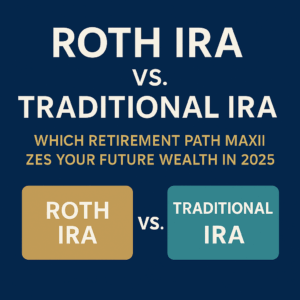Roth IRA vs. Traditional IRA: Which Retirement Path Maximizes Your Future Wealth in 2025?
In the ever-evolving landscape of personal finance, planning for retirement has become more critical than ever. As 2025 unfolds, two key options continue to dominate the conversation: the Roth IRA and the Traditional IRA. Both retirement accounts offer compelling tax advantages, but choosing the right one depends on your current financial situation, income level, and long-term goals.
A Roth IRA allows you to contribute post-tax income now and enjoy tax-free withdrawals in retirement—ideal for younger earners or anyone expecting to be in a higher tax bracket later. On the other hand, a Traditional IRA enables pre-tax contributions, lowering your taxable income today while deferring taxes until withdrawal. This may be the better choice for higher-income earners seeking immediate tax relief.
Each plan offers unique benefits, including contribution limits of $7,000 for 2025 (with an additional $1,000 catch-up contribution for those 50 or older), a wide range of investment options, and compound growth potential. Both options can significantly boost your retirement savings—but understanding their differences ensures you leverage the most value over time.
Choosing between a Roth and a Traditional IRA is not just a tax decision—it’s a strategy that shapes your financial future. Whether you’re starting your career or nearing retirement, now is the time to reassess which account aligns best with your evolving financial needs. With the right choice, your IRA can serve as a powerful tool to build lasting wealth and financial freedom.

Why a Roth or Traditional IRA Can Be a Game-Changer for Your Retirement
Tax Benefits Tailored to Your Situation
Whether you prefer upfront tax deductions (Traditional IRA) or tax-free growth and withdrawals (Roth IRA), both options allow you to structure your savings in the most tax-efficient way for your situation.Flexible Investment Options
IRAs typically allow a broad range of investments, including stocks, bonds, ETFs, and mutual funds. This means you can diversify your portfolio and align it with your risk tolerance and retirement horizon.Compound Growth Over Time
Both IRAs harness the power of compound interest. The earlier you contribute, the more time your investments have to grow exponentially—giving you a significant financial cushion in retirement.Catch-Up Contributions for Older Investors
For individuals aged 50 or older, both IRAs allow an additional $1,000 contribution annually. This feature helps late starters increase their nest egg and make up for lost time.
Understanding the Drawbacks Before You Commit
Contribution Limits May Restrict High Earners
In 2025, the contribution limit is $7,000 (or $8,000 for those 50+), which might not be sufficient for high-income individuals aiming to maximize their retirement savings. However, these accounts are most powerful when combined with other investment tools like 401(k)s or taxable brokerage accounts.Withdrawal Rules Can Be Restrictive
Withdrawing from a Traditional IRA before age 59½ typically triggers penalties and taxes. Even Roth IRAs, while more flexible, require you to wait five years before accessing earnings penalty-free. Still, careful planning can help you navigate these rules without issue.
How to Open a Roth or Traditional IRA in 2025
Opening an IRA in 2025 is easier than ever, thanks to digital platforms and a wide range of financial institutions offering guided onboarding processes. Whether you choose a Roth or Traditional IRA depends on your income level, tax strategy, and retirement timeline. But both can be opened online in minutes with minimal paperwork.
Before starting, it’s important to review your current income, assess your tax filing status, and decide which IRA aligns with your financial goals. Then, select a trusted provider—be it a brokerage firm, robo-advisor, or traditional bank. Most platforms will walk you through your account setup, risk profile, and investment preferences.
Having your Social Security Number, employment details, and banking information ready will speed up the process. Once your account is funded, you can begin investing immediately and take control of your retirement strategy.
Choose Between Roth or Traditional IRA
Evaluate your current and future tax situation to select the account type that benefits you most.Select a Financial Institution
Choose a reputable provider offering low fees, quality investment tools, and reliable customer support.Complete the Application
Provide your personal information, employment status, income range, and beneficiary details.Fund Your Account
Transfer funds via bank account, direct deposit, or IRA rollover if you’re consolidating from another plan.Choose Your Investments
Pick mutual funds, ETFs, stocks, or target-date funds that match your retirement timeline and risk tolerance.
Choosing between a Roth IRA and a Traditional IRA is one of the most important decisions you can make to secure your financial future. Both offer powerful retirement savings tools, and each shines in different scenarios. A Roth IRA is perfect for younger professionals or those anticipating a higher income in retirement, as it offers tax-free growth and withdrawals. Meanwhile, the Traditional IRA suits those who prefer upfront tax deductions and may benefit more from reducing their current taxable income.
Both accounts support compound growth, offer flexibility in investment choices, and can be customized to meet your evolving financial needs. Additionally, catch-up contributions for individuals over 50 provide a second chance for late starters to bulk up their retirement funds.
While there are limits to how much you can contribute and when you can withdraw without penalty, these drawbacks are easily manageable with good planning. By diversifying across multiple retirement vehicles and staying informed about tax law changes, you can use either IRA to great effect.
Ultimately, the best IRA for 2025 and beyond is the one that aligns with your current financial situation and long-term vision. With minimal effort to open, low fees from many online providers, and major tax advantages, now is the time to take action. Invest smartly today, and you’ll thank yourself tomorrow with the financial freedom to live the retirement you’ve always imagined.
Our Post

High Interest Rates, Credit Cards and the U.S. Consumer: What to Know in 2025
The Note: How Decelerating U.S. Economic Growth Affects Using Consumer Credit


